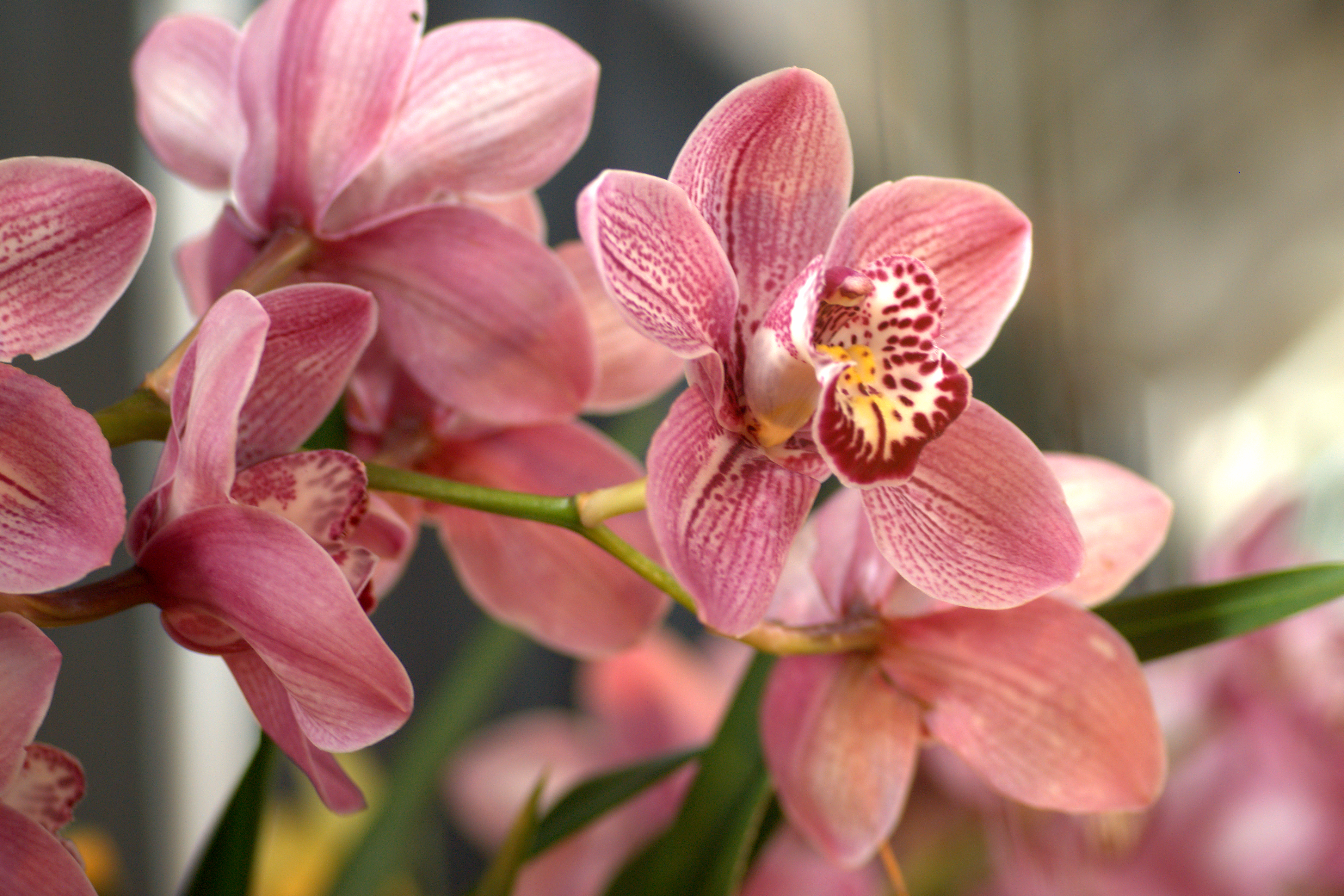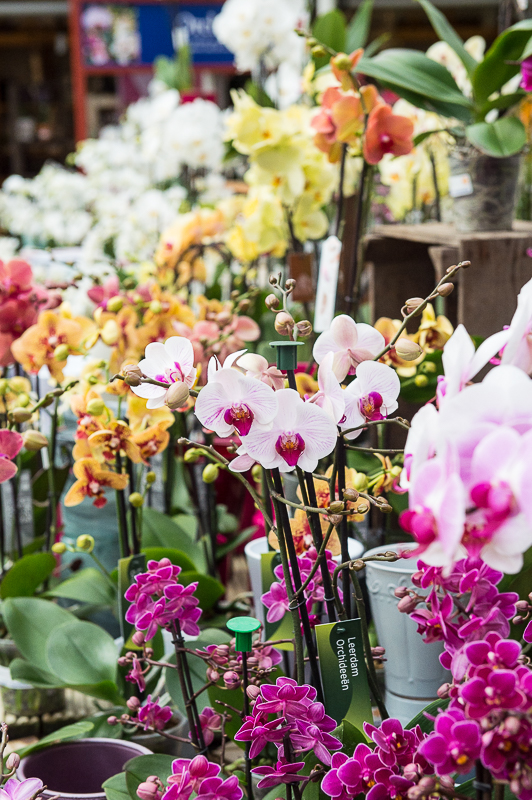- Home
- About
- Visiting Us
- AylettPlus
- Online Shop
- Our Range
- Plant Finder
- Seasons Café
- Events
- News
- Sustainability
- Contact Us
01727 822255
info@aylettnurseries.co.uk
Orchid Plants
Orchids are amongst our top selling houseplants. Their beautiful exotic flowers come in a range of flower shapes and colours meaning there is one to suit every taste, and they fit well within many home decor styles.
Long flowering periods mean they are excellent value for money compared to a cut flower arrangement and for this reason, Orchid plants make fantastic gifts!
Which type of Orchid shall I choose…?
PHALAENOPSIS ORCHIDS
Thick-leaved plants with elegant, arching sprays of blooms.
- Commonly known as ‘Moth orchids’

- Descended from species originating in the tropics of the Far East
- In the right conditions, Phalaenopsis require very little care but can give months of showy blooms
- Position in filtered light in spring and bright light in winter – avoid direct sunlight as leaves will burn
- Water when dry and when the plant feels light. Thoroughly water from the tap and allow water to wash through freely – do not stand in water
- Try to keep water out of the crown of the plant
- Phalaenopsis prefer an even temperature
- Humidity is also important to the Phalaenopsis. We recommend standing the orchid on a saucer of wet Hydroleca, but ensuring the base of the pot is NEVER standing in water
- In nature, their roots cling to and ramble along tree limbs where they are exposed to the air and are fertilised by washings from tree leaves, bird droppings and decayed remains of animals and plants living on the same host tree
Read our Phalaenopsis Leaflet here
ODONTOGLOSSUM ORCHIDS
Considered by many to be the most graceful and beautiful of all orchid plants. Popular for ease of growing and long-lasting sprays of small, distinct flowers which often have unique colour combinations and a pleasant fragrance.
 This group includes; Oncidiums and Vuylstekeara and Dendrobium
This group includes; Oncidiums and Vuylstekeara and Dendrobium- Native to tropical and sub-tropical Central and South America
- This group prefers bright filtered light with some direct sunlight in winter
- Will do well in quite cool conditions although in winter the temperature should not be below 10oC (50oF) at night and then only if the plants are rather dry at the roots. As growth begins in spring, increase the temperature by a few degrees. The maximum summer temperature should be around 25oC (76oF). The ideal temperature is 17oC (60oF)
- Due to the mixed pedigree of this group, most of the plants tend to flower every nine months, regardless of the time of year
- Situate in bright filtered light
- Keep fairly moist, but not waterlogged, keep drier in winter if the temperature is cool
- In hot weather keep well ventilated and spray with water but avoid draughts
- To increase humidity, stand on a tray of moist Hydroleca
CYMBIDIUM ORCHIDS
Highly decorative flower spikes.
- Commonly known as ‘Boat Orchids’

- Cymbidiums are one of the most widely grown Orchids in cultivation
- Originating from the Himalayas, these cool growing orchids will not flower if grown too warm or, under too much shade
- They are winter flowering, blooming between October and May, depending on the variety. They usually flower every year but even so a few plants will miss a year, and many varieties give a reduced quantity of blooms every other year
- Most growth occurring from May to mid-October
- Usually grown in conservatories or cool greenhouses, where a night temperature above 7oC (46oF) can be maintained
- A plant with several spikes can provide a splendid display of blooms for up to three months if given fresh air, daytime temperatures up to 21oC or 22oC (70 or 72oF) and positioned where it will benefit from window light without chilling draughts
- Ideal for a conservatory or heated greenhouse or porch with a winter temperature of 7˚C-13˚C at night and a maximum of 21˚C in the day
- Good light and air movement are essential, but protect from strong sun
- Keep compost moist but not soggy
- Stand outside in summer from June to the middle of September. Cool nighttime temperatures are essential for flower development
- Repot every 2-3 years between March and early July using Orchid repotting mix
MILTONIA ORCHIDS
Huge showy flowers, closely resembling the pansy, providing a delicate, exotic scent over two leaves.
- Also known as “Pansy – orch
 ids”
ids” - Region of origin extends from the Andes in Colombia to Peru and Ecuador. Miltonia are epiphytes, in its home region, the plant grows on the fringes and in open spaces in mountain forests on moss-covered branches
- Flower best in lower temperatures (minimum of 13 C (55ºF), with daytime temperatures of 16-19ºC (60-65ºF)
- Need semi-humid conditions
- Flowering generally occurs once a year but often can appear after intervals of 8 – 9 months. The main flowering being from late spring through summer
- In the sunshine, the blooms are often scented but try not to knock them – they bruise easily
- Look best if grown into clumps and flowering is normally enhanced in a larger plant
- Place in filtered light most of the year, moving to a brighter position in winter
- Water using tepid rainwater when possible to keep the compost moist but not wet. Ensure the plant is not left standing in water
- Requires semi-humid conditions, the foliage will benefit from a daily light misting of the leaves.
PAPHIOPEDILUM ORCHIDS
Elegant voluptuous flowers with eye-catching, slipper-like flowers with sweeping petals on a slender stem over tall, attractive, glossy, dark green or mottled foliage.
- Origin
 ate from the Indian Archipelago
ate from the Indian Archipelago - “Lady Slipper” orchid is named because the pouch-shaped lip of their flowers looks very much like a slipper
- Paphiopedilums require less light than many orchids, place in an area that gets reflected or subdued light, not bright sun
- The blooming period generally begins in November and continues through to March providing a long-lasting floral show in the middle of winter. A few varieties blooming during the summer months.
- The exotic wax-like richly coloured blooms can last for weeks – sometimes months!
- Keep continuously moist, but not soggy or waterlogged, generally water every 3-7 days or when the pot feels light.
- Lightly mist once or twice a day to improve humidity.
- Feed with an Orchid Fertiliser every other watering.
Browse our range in-store
We stock a fantastic selection of Orchid plants in our Houseplant Department and our team are on hand to help with your selection. For further information call us on 01727 822255 or email us on info@aylettnurseries.co.uk.




